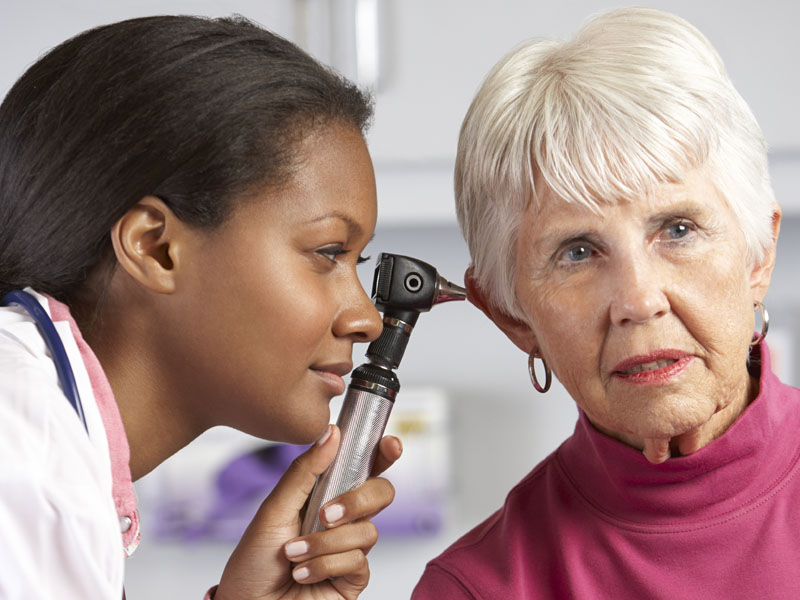Final Recommendation Statement
USPSTF: Insufficient Evidence to Screen for Hearing Loss
April 2, 2021, 4:00 p.m. News Staff — On March 23, the U.S. Preventive Services Task force posted a final recommendation statement, final evidence review and evidence summary on screening for hearing loss in older adults.

Based on its review, the task force concluded that the current evidence is insufficient to assess the balance of benefits and harms of screening for hearing loss in older adults. This is an “I” recommendation, and applies to asymptomatic individuals 50 years or older with age-related hearing loss. The recommendation does not apply to those with hearing loss that is conductive, congenital, sudden or caused by recent noise exposure, or to individuals reporting signs and symptoms of hearing loss.
“More research is needed to determine if there are benefits or harms of screening for hearing loss in people who have not reported problems with their hearing,” said Chien-Wen Tseng, M.D., M.P.H., M.S.E.E., the research director in the Department of Family Medicine and Community Health at the University of Hawaii John A. Burns School of Medicine and a member of the task force, in a press release. “We also need more trials in the general adult population to demonstrate how screening all older adults may impact quality of life.
“Given the insufficient evidence, clinicians should use their judgment to determine whether or not to screen older adult patients for hearing loss,” Tseng added, saying that patients who have concerns about their hearing should talk to their clinician.
Also known as presbycusis, age-related hearing loss is a common condition among older and elderly adults. The National Institute on Deafness and Other Communication Disorders estimates that about one-third of adults ages 65 to 74, and nearly half of adults older than 75, have difficulty hearing. Over time, hearing loss can make it difficult for older adults to communicate with others or to respond to phones, doorbells and alarms, which can affect their quality of life and ability to function independently.
Update of Previous Recommendation
The current recommendation statement is consistent with the USPSTF’s August 2012 recommendation statement on the topic, which also concluded that there was insufficient evidence to assess the balance of benefits and harms of screening for hearing loss in asymptomatic adults 50 or older. The AAFP supported the 2012 recommendation.
Story Highlights
To update its recommendation, the task force commissioned a systematic review to determine the benefits and harms of screening for hearing loss, the accuracy of screening tools and the benefits and harms of interventions for screen-detected or recently diagnosed hearing loss in adults 50 years or older. Data sources included trials and trial registries published through Jan. 17, 2020, as well as reference lists of retrieved articles, outside experts and reviewers, with surveillance of the literature conducted through Nov. 20, 2020. The final evidence review included 41 unique studies.
Results
The task force found that several types of screening tools, such as questionnaires, whispered voice tests and handheld or mobile audiometric devices may reasonably identify older adults who have moderate hearing loss, with varying degrees of sensitivity and specificity reported for each tool based on different definitions of hearing loss.
Direct evidence to show the effect of screening for hearing loss on clinical outcomes was limited, and there was no direct evidence on harms associated with screening. While the researchers did note some potential harms, such as false-positive results that could lead to unnecessary testing and/or treatment, they stated because screening and confirmatory testing for hearing impairment are noninvasive and serious harms of treatment are rare, there are likely little to no adverse effects of screening for hearing loss.
The task force also noted several research gaps that need to be addressed. They called for screening trials that focus on health outcomes and that enroll asymptomatic older adults from a general primary care population, as well as studies on the potential harms of screening. In addition, the task force said there is a need for trials of screening and treatment for hearing loss that reflect currently available technologies and treatment standards, and they called for trials that use consistent definitions of hearing loss to help clarify the accuracy of relevant screening tests.
Response to Public Comment
A draft version of the recommendation statement was posted for public comment on the USPSTF website from Sep. 8, 2020, to Oct. 5, 2020.
Several respondents said that given the personal and financial costs of hearing impairment, the task force should recommend screening; in response, the USPSTF stated that it requires evidence on the benefits and harms of a preventive service in order to recommend that service, and provided additional information on outcomes such as cognitive function and quality of life in the final recommendation statement.
A number of commenters expressed the concern that the task force’s “I” statement could be perceived as a recommendation against screening. In response, the USPSTF clarified that the “I” statement is neither a recommendation for nor against screening, but rather a conclusion that the evidence is insufficient to assess the balance of benefits and harms of screening for hearing loss.
In response to questions about the scope of the recommendation, such as the exclusion of some patient populations and types of hearing loss, the USPSTF clarified that the recommendation focused on screening for sensorineural hearing loss, as it is the most common form of hearing loss in adults older than 50.
Finally, some commenters noted that the task force did not consider newer screening modalities that provide objective measures of hearing loss. The USPSTF stated that its review included an assessment of several newer screening tools, some of which showed promise but had limited evidence.
Next Steps
The AAFP’s Commission on Health of the Public and Science plans to review the task force’s final recommendation statement, final evidence summary and evidence review, and will then determine the Academy’s stance on the recommendation.